Intel P965: Mid-Range Performance Sector Roundup
by Gary Key on October 20, 2006 9:00 PM EST- Posted in
- Motherboards
Gigabyte GA-965P-DS3: Board Layout and Features
Gigabyte has provided us with a well engineered board with a very good layout, though we would say the color combination does not have a central theme and lacks cohesiveness. We just feel if a manufacturer is going to take the time to add colors to a motherboard then at least do it with a graphics artist nearby. However, the board was a breeze to install in our case and all connections were easily reached. The board features a three-phase voltage regulator system that provided excellent stability throughout our testing. Gigabyte has recently switched their upper end boards to 100% use of Conductive Polymer Aluminum Solid Capacitors instead of the typical Electrolytic Capacitor. The purpose for this is to improve system durability and to provide for added stability under heavy load operations such as overclocking. With the latest BIOS release this board is also ready for the new Intel Core 2 Extreme Quad-Core (Kentsfield) processors.
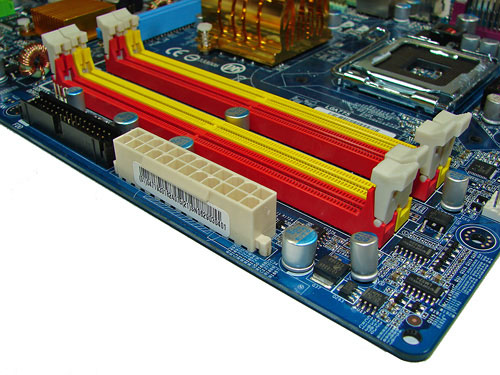
The DIMM module slots' color coordination is once again correct for dual channel setup based upon the premise of installing DIMMs in the same colored slots for dual-channel operation. The memory modules are slightly difficult to install with a full size video card placed in the PCI Express x16 slot. The 24-pin ATX power connector and black floppy drive connector are located along the edge of the board and behind the DIMM slots. The board only comes with two fan headers with the CPU fan header being located to the right of the first DIMM slot.
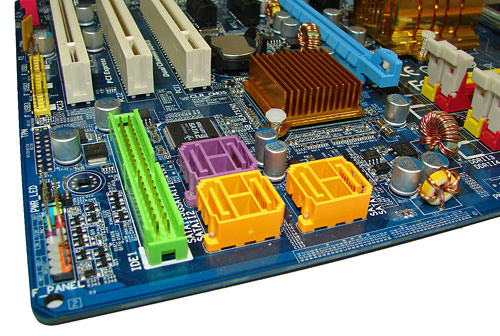
The four Intel ICH8 SATA ports are color coded yellow and the two JMicron JMB363 SATA ports are in a wonderful shade of lavender next to the green IDE connector. We found the positioning of the SATA ports to be excellent when utilizing the PCI 2.3 slots although we still prefer the IDE connector on the edge of the board to facilitate better cable management. The ICH8 is passively cooled with a gold colored low-rise heatsink and remained fairly cool to the touch throughout testing.
The chassis panel is located at the bottom left corner of the board. The clear CMOS jumper is located in between the battery and ICH8 chipset. This is a two pin configuration and requires the use of a pen to reach and is blocked if a card is installed in the first PCI slot. It seems to be a trend lately of the various manufacturers to place this jumper in the most inconvenient locations. Until the BIOS recovery programs work 100% of the time it would be nice to have this jumper out in the open, or even better go with the "button" design that we've seen used by a few manufacturers.
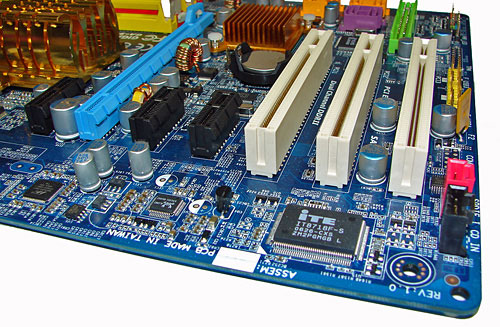
The board comes with (1) physical PCI Express x16 connector, (3) PCI Express x1 connectors, and (3) PCI 2.3 connectors. The layout of this design offers a very good balance of expansion slots for a mainstream performance board while providing excellent clearance space for graphics card utilization. The second PCI Express x1 slot will be blocked by a dual slot graphics card but considering the dearth of PCI Express peripherals this is fully acceptable. The first PCI Express x1 slot is a tight fit as a card installed in this slot will have minimal clearance between the MCH heatsink and video card.
Upon entering the CPU socket area, we find an ample amount of room for the majority of cooling solutions. We utilized the stock heatsink/fan in our base testing but also verified several of the larger Socket-775 cooling solutions would fit in this area during our overclocking tests. The 4-pin ATX power connector is placed on the far right side of the board and did not interfere with our various cooling units.
The Intel P965 MCH chipset is passively cooled with a mid-rise heatsink unit that did not interfere with any installed peripherals. Unfortunately, this heatsink is not very good at keeping the MCH cool during heavy overclocking. Gigabyte has used this design for the past year but has generally shipped a small fan that attaches to it for additional cooling. This heatsink needs it when running the system above 400FSB. However, even if it were included this board only has two fan headers which is not representative of a performance oriented board.

The rear panel contains the standard PS/2 mouse and keyboard ports along with serial and parallel ports for those who still require legacy peripherals. The panel also includes a LAN port, 4 USB ports, and two S/PDIF (optical out/coaxial out) ports. The LAN (RJ-45) port has two LED indicators representing Activity and Speed of the connection through the Marvell 88E8053 Gigabit PCI-E chipset. The audio panel consists of 6 ports that can be configured for 2, 4, 6, and 8-channel audio connections for the Realtek ALC 883 HD codec. The only item missing from our wish list would be a Firewire port if the board supported it.
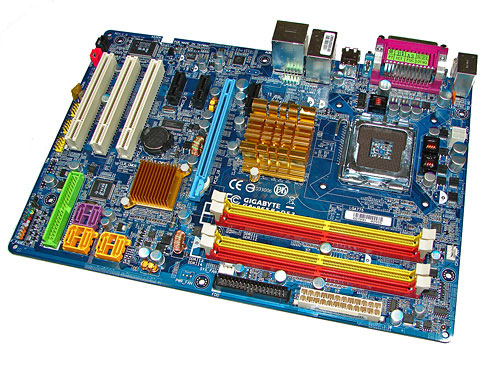 |
| Click to enlarge |
Gigabyte has provided us with a well engineered board with a very good layout, though we would say the color combination does not have a central theme and lacks cohesiveness. We just feel if a manufacturer is going to take the time to add colors to a motherboard then at least do it with a graphics artist nearby. However, the board was a breeze to install in our case and all connections were easily reached. The board features a three-phase voltage regulator system that provided excellent stability throughout our testing. Gigabyte has recently switched their upper end boards to 100% use of Conductive Polymer Aluminum Solid Capacitors instead of the typical Electrolytic Capacitor. The purpose for this is to improve system durability and to provide for added stability under heavy load operations such as overclocking. With the latest BIOS release this board is also ready for the new Intel Core 2 Extreme Quad-Core (Kentsfield) processors.

The DIMM module slots' color coordination is once again correct for dual channel setup based upon the premise of installing DIMMs in the same colored slots for dual-channel operation. The memory modules are slightly difficult to install with a full size video card placed in the PCI Express x16 slot. The 24-pin ATX power connector and black floppy drive connector are located along the edge of the board and behind the DIMM slots. The board only comes with two fan headers with the CPU fan header being located to the right of the first DIMM slot.

The four Intel ICH8 SATA ports are color coded yellow and the two JMicron JMB363 SATA ports are in a wonderful shade of lavender next to the green IDE connector. We found the positioning of the SATA ports to be excellent when utilizing the PCI 2.3 slots although we still prefer the IDE connector on the edge of the board to facilitate better cable management. The ICH8 is passively cooled with a gold colored low-rise heatsink and remained fairly cool to the touch throughout testing.
The chassis panel is located at the bottom left corner of the board. The clear CMOS jumper is located in between the battery and ICH8 chipset. This is a two pin configuration and requires the use of a pen to reach and is blocked if a card is installed in the first PCI slot. It seems to be a trend lately of the various manufacturers to place this jumper in the most inconvenient locations. Until the BIOS recovery programs work 100% of the time it would be nice to have this jumper out in the open, or even better go with the "button" design that we've seen used by a few manufacturers.

The board comes with (1) physical PCI Express x16 connector, (3) PCI Express x1 connectors, and (3) PCI 2.3 connectors. The layout of this design offers a very good balance of expansion slots for a mainstream performance board while providing excellent clearance space for graphics card utilization. The second PCI Express x1 slot will be blocked by a dual slot graphics card but considering the dearth of PCI Express peripherals this is fully acceptable. The first PCI Express x1 slot is a tight fit as a card installed in this slot will have minimal clearance between the MCH heatsink and video card.
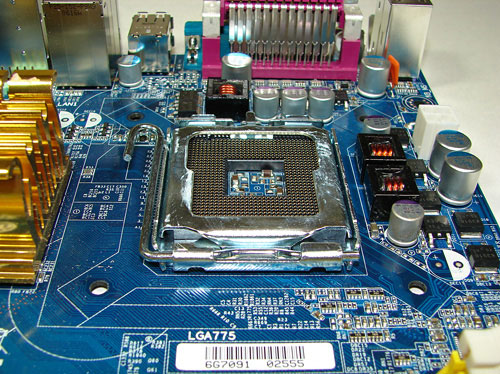 |
| Click to enlarge |
Upon entering the CPU socket area, we find an ample amount of room for the majority of cooling solutions. We utilized the stock heatsink/fan in our base testing but also verified several of the larger Socket-775 cooling solutions would fit in this area during our overclocking tests. The 4-pin ATX power connector is placed on the far right side of the board and did not interfere with our various cooling units.
The Intel P965 MCH chipset is passively cooled with a mid-rise heatsink unit that did not interfere with any installed peripherals. Unfortunately, this heatsink is not very good at keeping the MCH cool during heavy overclocking. Gigabyte has used this design for the past year but has generally shipped a small fan that attaches to it for additional cooling. This heatsink needs it when running the system above 400FSB. However, even if it were included this board only has two fan headers which is not representative of a performance oriented board.

The rear panel contains the standard PS/2 mouse and keyboard ports along with serial and parallel ports for those who still require legacy peripherals. The panel also includes a LAN port, 4 USB ports, and two S/PDIF (optical out/coaxial out) ports. The LAN (RJ-45) port has two LED indicators representing Activity and Speed of the connection through the Marvell 88E8053 Gigabit PCI-E chipset. The audio panel consists of 6 ports that can be configured for 2, 4, 6, and 8-channel audio connections for the Realtek ALC 883 HD codec. The only item missing from our wish list would be a Firewire port if the board supported it.










62 Comments
View All Comments
JarredWalton - Saturday, October 21, 2006 - link
Oh, trust me, Gary tested with a LOT of RAM types and manufacturers. However, for the *benchmarks* he settled on one specific set of DIMMs. I think he's trying to put together some information on how the various boards worked with other RAM (see above comment from Gary). Cheers!stmok - Saturday, October 21, 2006 - link
LOL...I think its more like: "What the hell were the Abit engineers thinking?!"Based on your experiences, do you know if the Analog Devices AD1988A HD Audio Codec works in Linux? I wouldn't mind going for the ASUS P5B-E at the end of the year.
And finally, is the rev 1.02G mobo available now? Or in a few months time?
Gary Key - Saturday, October 21, 2006 - link
The 1.09 ADI AD1988A drivers worked fine in SUSE 10.1. Realtek has better support at this time but ADI seems to be catching up. Believe it or not, but we booted every board with SUSE 10.1 just to make sure they went to the desktop. We might even do a once in a while look at Linux down the road.
xsilver - Saturday, October 21, 2006 - link
what is the range of overclocking possible with pc6400 ram?without dividers? with dividers?
Gary Key - Saturday, October 21, 2006 - link
Good question, depends on the PC2-6400 RAM. We are working on something right now to answer your question with a few different modules.xsilver - Sunday, October 22, 2006 - link
probably something standard like corsair VS or something priced very similar if there is better performance elsewherexsilver - Sunday, October 22, 2006 - link
also I would assume that 1gig vs. 2gig makes no difference but if it does, it would be good to know.Madellga - Saturday, October 21, 2006 - link
Excellent review Gary. I also look forward for the round 2 and also for a 975/ATI/Nvidia reviews.Please try to mention the Vmch used for the overclocking results, as this says a lot about the motherboads also.
Gary Key - Saturday, October 21, 2006 - link
I am setting up a overclocking settings table and will try to show some additional results with different memory types that we used in testing. I have no idea when this will be finished. ;-)Ryan Norton - Saturday, October 21, 2006 - link
This article is terrific-- now I just need to read the high-end part and I can finally put together a Core 2 Duo system.Will the DS4 be included in the high-end guide? I don't want a DQ-6 because the copper backplate under the processor socket would prevent installation of a Scythe Ninja heatsink.
Are the AHCI issues going to stay the way they are, with needing to load the drivers from a floppy disk during Windows install, or are there any P965 boards that don't require "an engineering degree and a day off" as you guys said?